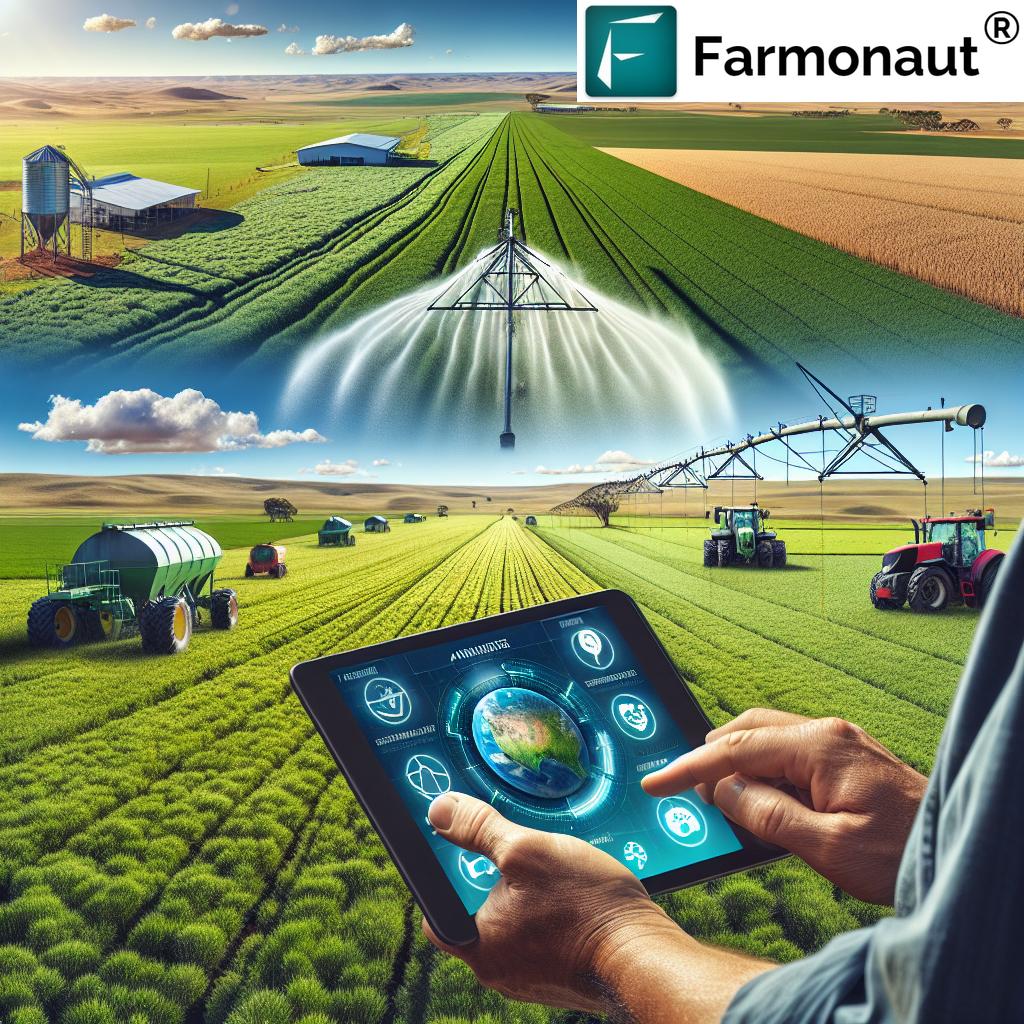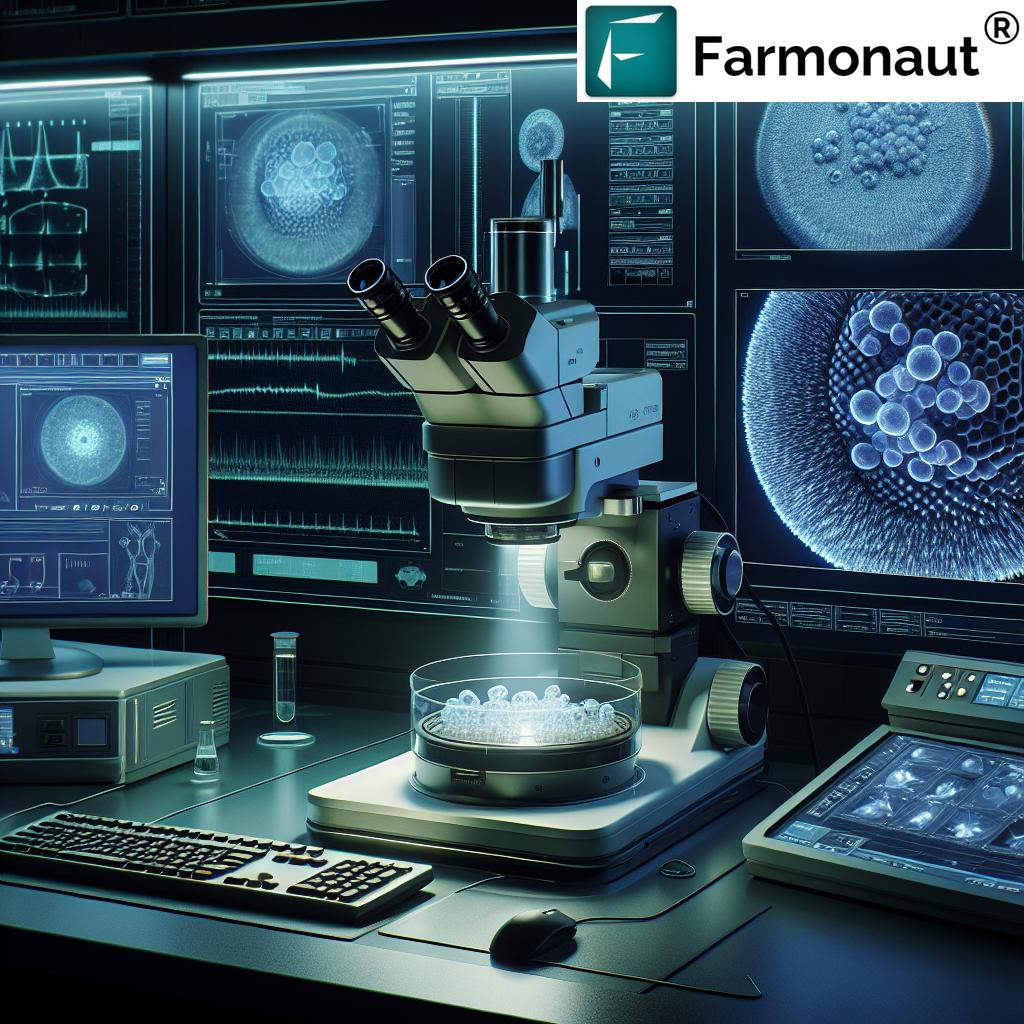Farmonaut: Revolutionizing Australian Agriculture with Sustainable Practices and Biosecurity Measures for a Resilient Future
“Australia aims to grow its agriculture sector to $100 billion by 2030 through sustainable practices and innovative technologies.”
In the vast expanse of Australia’s agricultural landscape, a revolution is underway. As we navigate the challenges of climate change, biosecurity threats, and the ever-increasing demand for food security, the Australian agriculture industry is embracing sustainable practices and cutting-edge technologies to forge a resilient future. At the forefront of this transformation is Farmonaut, a pioneering agricultural technology company that is reshaping the way we approach farming in the 21st century.

In this comprehensive exploration, we’ll delve into how sustainable agricultural practices and robust biosecurity measures are shaping the future of farming in Australia. We’ll examine the critical role of animal welfare standards, innovative agtech solutions, and collaborative efforts among key agricultural bodies in driving industry growth. Join us as we uncover the intricate web of initiatives aimed at addressing climate change impacts, managing pests and diseases, and enhancing food security for a growing global population.
The Australian Agricultural Landscape: Challenges and Opportunities
Australia’s agriculture sector is a cornerstone of the nation’s economy, contributing significantly to both domestic food security and international trade. However, the industry faces a myriad of challenges that demand innovative solutions:
- Climate Change: Shifting weather patterns, increased frequency of extreme events, and prolonged droughts pose significant risks to crop yields and livestock management.
- Biosecurity Threats: As a geographically isolated continent, Australia must maintain vigilant biosecurity measures to protect its unique ecosystems and agricultural assets from pests and diseases.
- Resource Management: Efficient use of water, soil, and other natural resources is crucial for sustainable long-term agricultural production.
- Market Access: Maintaining and expanding international trade opportunities requires adherence to strict quality standards and traceability measures.
Despite these challenges, the Australian agriculture industry has set an ambitious goal of becoming a $100 billion sector by 2030. Achieving this target requires a multifaceted approach that combines sustainable practices, technological innovation, and strategic policy-making.
Sustainable Agricultural Practices: The Foundation of Future Farming
Sustainable agriculture is no longer just an option; it’s a necessity for the long-term viability of the sector. Australian farmers are increasingly adopting practices that not only boost productivity but also protect the environment and ensure the welfare of livestock.
- Conservation Agriculture: Techniques such as no-till farming, crop rotation, and cover cropping are helping to improve soil health, reduce erosion, and increase carbon sequestration.
- Precision Agriculture: By leveraging data-driven insights, farmers can optimize resource use, reduce waste, and enhance crop yields.
- Integrated Pest Management (IPM): This holistic approach combines biological, cultural, and chemical methods to manage pests while minimizing environmental impact.
- Water-Efficient Irrigation: Advanced irrigation systems and water management strategies are crucial in a country prone to drought.
Farmonaut’s satellite-based crop health monitoring system plays a pivotal role in supporting these sustainable practices. By providing real-time data on vegetation health, soil moisture levels, and other critical metrics, Farmonaut empowers farmers to make informed decisions that optimize resource use and minimize environmental impact.
Biosecurity Measures: Safeguarding Australia’s Agricultural Future
Australia’s unique geographical isolation has allowed it to remain free from many pests and diseases that plague agriculture in other parts of the world. However, this also means that the country’s ecosystems are particularly vulnerable to introduced threats. Robust biosecurity measures are essential for protecting Australia’s agricultural assets and maintaining its reputation as a producer of clean, safe food products.
Key aspects of Australia’s biosecurity strategy include:
- Border Control: Strict quarantine procedures and import regulations to prevent the entry of potentially harmful organisms.
- Surveillance and Monitoring: Continuous monitoring of crops and livestock for early detection of pests and diseases.
- Emergency Response Protocols: Well-defined procedures for rapid response to biosecurity incursions.
- Research and Innovation: Ongoing investment in scientific research to develop new tools and strategies for biosecurity management.
Farmonaut’s advanced satellite imagery and AI-driven analysis contribute significantly to these biosecurity efforts. By providing early detection of crop health issues, Farmonaut helps farmers and biosecurity agencies identify and respond to potential threats more quickly and effectively.
Animal Welfare Standards: Ethical Production for a Discerning Market
Australia’s commitment to animal welfare is not just an ethical imperative; it’s also a key factor in maintaining market access and consumer trust. The industry has developed comprehensive animal welfare standards that cover all aspects of livestock production, from breeding and housing to transportation and processing.
Key elements of Australia’s animal welfare approach include:
- Science-Based Standards: Welfare guidelines are developed based on the latest scientific research and best practices.
- Training and Education: Ongoing programs to ensure farmers and livestock handlers are well-versed in animal welfare principles.
- Auditing and Compliance: Regular inspections and audits to ensure adherence to welfare standards.
- Innovation in Husbandry: Development of new technologies and practices to improve animal comfort and reduce stress.
While Farmonaut’s primary focus is on crop management, its data analysis capabilities can indirectly support animal welfare efforts by optimizing pasture management and feed production, ensuring that livestock have access to high-quality nutrition.
“Farmonaut’s precision agriculture tools are helping Australian farmers adapt to climate change impacts across millions of hectares.”
Climate Change Adaptation: Building Resilience in Australian Agriculture
The impacts of climate change pose significant challenges to Australian agriculture, from altered rainfall patterns to increased frequency of extreme weather events. Adapting to these changes is crucial for maintaining productivity and ensuring long-term food security.
Key strategies for climate change adaptation include:
- Drought-Resistant Crop Varieties: Development and adoption of crops that can thrive in water-scarce conditions.
- Diversification: Encouraging farmers to diversify their production to spread risk and increase resilience.
- Climate-Smart Agriculture: Implementing practices that reduce greenhouse gas emissions while improving productivity.
- Water Management: Investing in water-saving technologies and improving water use efficiency across the agricultural sector.
Farmonaut’s satellite-based monitoring and AI-driven advisory system play a crucial role in climate change adaptation. By providing real-time data on crop health, soil moisture, and weather patterns, Farmonaut enables farmers to make timely decisions that mitigate the impacts of changing climatic conditions.
Explore Farmonaut’s API for advanced agricultural data analysis
Precision Agriculture Technologies: Data-Driven Farming for Optimal Results
Precision agriculture is revolutionizing the way farmers manage their land and resources. By leveraging advanced technologies, farmers can optimize inputs, increase yields, and reduce environmental impact.
Key components of precision agriculture include:
- Satellite Imagery: High-resolution imagery for monitoring crop health and identifying issues early.
- IoT Sensors: Network of sensors to collect real-time data on soil conditions, weather, and crop growth.
- GPS-Guided Equipment: Precise application of inputs and efficient harvesting techniques.
- Data Analytics: Advanced algorithms to process and interpret large volumes of agricultural data.
Farmonaut is at the forefront of this precision agriculture revolution. Its platform integrates satellite imagery, AI analysis, and machine learning to provide farmers with actionable insights for improved decision-making.
Collaborative Efforts: Key Agricultural Bodies Driving Change
The transformation of Australian agriculture is not the work of any single entity but a collaborative effort involving government agencies, research institutions, industry associations, and innovative companies like Farmonaut. Some of the key players in this collaborative ecosystem include:
- Department of Agriculture, Fisheries and Forestry (DAFF): Responsible for developing and implementing national policies and programs to support the agriculture sector.
- CSIRO: Australia’s national science agency, conducting cutting-edge research in agricultural science and technology.
- Meat & Livestock Australia (MLA): Industry body working to improve productivity and sustainability in the red meat sector.
- Grains Research and Development Corporation (GRDC): Investing in research, development, and extension to enhance the productivity and sustainability of grain farming.
These organizations, along with many others, work together to address the complex challenges facing Australian agriculture. Their efforts span research, policy development, technology adoption, and on-ground implementation of sustainable practices.
The Role of Agtech in Shaping Australia’s Agricultural Future
Agricultural technology, or agtech, is playing an increasingly vital role in the transformation of Australian farming. From AI-driven crop management systems to blockchain-based supply chain solutions, agtech is helping farmers increase productivity, reduce costs, and improve sustainability.
Key areas of agtech innovation include:
- Remote Sensing and Monitoring: Satellite and drone-based technologies for crop and livestock monitoring.
- Artificial Intelligence and Machine Learning: Advanced algorithms for predictive analytics and decision support.
- Robotics and Automation: Autonomous machinery for planting, harvesting, and processing.
- Blockchain and Traceability: Secure, transparent systems for tracking agricultural products from farm to consumer.
Farmonaut’s suite of technologies exemplifies the potential of agtech to revolutionize farming practices. By combining satellite imagery, AI analysis, and blockchain technology, Farmonaut provides a comprehensive solution for modern agricultural management.
Access Farmonaut’s API Developer Docs for integration into your agricultural solutions
Enhancing Food Security: From Farm to Table
As the global population continues to grow, ensuring food security becomes increasingly critical. Australian agriculture plays a vital role in both domestic food supply and international exports. Enhancing food security involves multiple aspects:
- Increasing Productivity: Adopting technologies and practices that boost crop yields and livestock production.
- Reducing Food Waste: Implementing better storage, transportation, and processing techniques to minimize losses.
- Improving Nutritional Quality: Developing crops with enhanced nutritional profiles to address malnutrition.
- Ensuring Food Safety: Maintaining rigorous standards throughout the supply chain to prevent contamination and foodborne illnesses.
Farmonaut’s technologies contribute to food security efforts by helping farmers optimize production, reduce losses, and ensure the quality of their products. The company’s blockchain-based traceability solutions also play a crucial role in maintaining food safety standards and building consumer trust.
The Economic Impact: Driving Growth in Rural Australia
The transformation of Australian agriculture is not just about environmental sustainability and food security; it’s also a significant driver of economic growth, particularly in rural areas. The adoption of sustainable practices and innovative technologies is creating new opportunities and challenges for rural communities:
- Job Creation: The growth of the agtech sector is creating new, high-skilled jobs in rural areas.
- Increased Farm Profitability: Improved efficiency and productivity lead to better economic outcomes for farmers.
- Diversification of Rural Economies: The integration of technology and sustainable practices is attracting new industries to rural areas.
- Export Opportunities: Australia’s reputation for clean, safe agricultural products opens up new markets and export potential.
Farmonaut’s technologies contribute to this economic growth by helping farmers optimize their operations, reduce costs, and increase yields. The company’s platform also provides valuable data that can inform economic planning and investment decisions in the agricultural sector.
The Path Forward: Challenges and Opportunities
As we look to the future of Australian agriculture, several key challenges and opportunities emerge:
- Technology Adoption: Encouraging widespread adoption of innovative technologies across diverse farming communities.
- Skills Development: Ensuring farmers and agricultural workers have the skills needed to leverage new technologies and practices.
- Policy Support: Developing regulatory frameworks that encourage innovation while protecting environmental and social interests.
- International Collaboration: Fostering partnerships to share knowledge and address global agricultural challenges.
Farmonaut is well-positioned to play a crucial role in addressing these challenges. By providing accessible, user-friendly technologies and supporting farmers in their adoption of sustainable practices, Farmonaut is helping to shape a more resilient and prosperous future for Australian agriculture.

Australian Agriculture Sustainability Initiatives
| Initiative | Description | Implementing Bodies | Estimated Impact |
|---|---|---|---|
| Precision Agriculture Technologies | Implementation of satellite-based monitoring, IoT sensors, and data analytics for optimized farming | CSIRO, Farmonaut, AgTech companies | 20-30% increase in productivity across adopting farms |
| Biosecurity Measures | Enhanced border control, surveillance systems, and rapid response protocols | DAFF, State Agricultural Departments | $2.5 billion annual savings from prevented pest and disease incursions |
| Animal Welfare Standards | Implementation of science-based welfare guidelines across livestock industries | MLA, Australian Pork Limited, Dairy Australia | Improved market access and 10% premium on ethical animal products |
| Climate Change Adaptation Strategies | Development of drought-resistant crops, water-efficient irrigation systems, and climate-smart farming practices | GRDC, Cotton Research and Development Corporation | 15% reduction in climate-related crop losses by 2030 |
Conclusion: A Sustainable, Resilient Future for Australian Agriculture
The journey towards a $100 billion Australian agriculture sector by 2030 is well underway, driven by a commitment to sustainability, innovation, and collaboration. By embracing sustainable agricultural practices, implementing robust biosecurity measures, and leveraging cutting-edge technologies, Australian farmers are not just adapting to challenges – they’re thriving in the face of them.
Companies like Farmonaut are at the forefront of this agricultural revolution, providing the tools and insights needed to make data-driven decisions, optimize resource use, and ensure long-term sustainability. As we move forward, the continued integration of agtech solutions, coupled with ongoing research and policy support, will be crucial in realizing the full potential of Australian agriculture.
The future of farming in Australia is not just about producing more; it’s about producing smarter, more sustainably, and with greater resilience. It’s a future where technology and tradition work hand in hand, where the health of the land is as important as the yield of the crop, and where the prosperity of rural communities goes hand in hand with the success of the agricultural sector.
As we navigate this exciting period of transformation, one thing is clear: the seeds of a sustainable, resilient, and prosperous agricultural future have been sown. With continued innovation, collaboration, and commitment to sustainability, Australian agriculture is well-positioned to meet the challenges of the 21st century and beyond.
Frequently Asked Questions (FAQ)
- What is Farmonaut and how does it contribute to sustainable agriculture in Australia?
Farmonaut is an agricultural technology company that provides satellite-based farm management solutions. It contributes to sustainable agriculture by offering real-time crop health monitoring, AI-based advisory systems, and resource management tools, helping farmers make informed decisions to optimize yields and reduce environmental impact. - How do biosecurity measures protect Australian agriculture?
Biosecurity measures protect Australian agriculture by preventing the entry and spread of harmful pests and diseases. This includes strict border controls, surveillance systems, and rapid response protocols, which safeguard the country’s unique ecosystems and maintain its reputation for clean, safe agricultural products. - What role does precision agriculture play in Australia’s farming future?
Precision agriculture plays a crucial role by leveraging data-driven insights to optimize resource use, reduce waste, and enhance crop yields. Technologies like satellite imagery, IoT sensors, and AI-driven analytics help farmers make more accurate decisions about planting, irrigation, and harvesting. - How is Australia addressing climate change impacts on agriculture?
Australia is addressing climate change impacts through various strategies, including developing drought-resistant crop varieties, implementing water-efficient irrigation systems, diversifying production, and adopting climate-smart agricultural practices that reduce greenhouse gas emissions while improving productivity. - What is the economic impact of sustainable agricultural practices on rural Australia?
Sustainable agricultural practices are driving economic growth in rural Australia by creating new job opportunities, increasing farm profitability, diversifying rural economies, and opening up new export markets for clean, safe agricultural products.




















